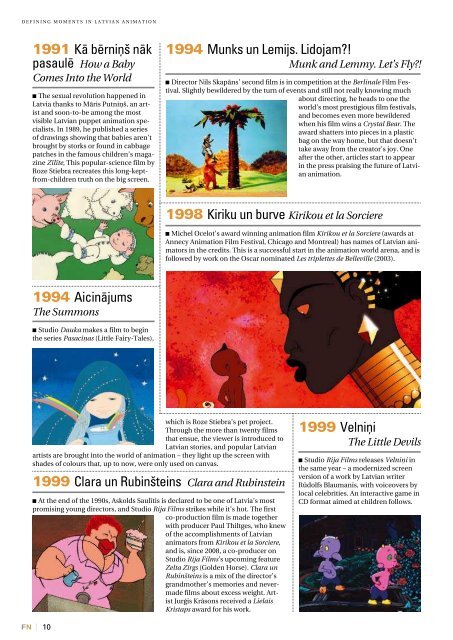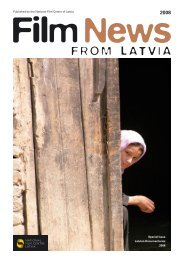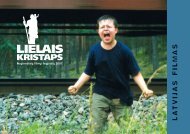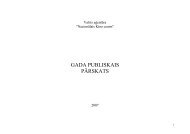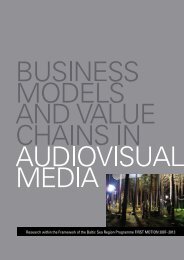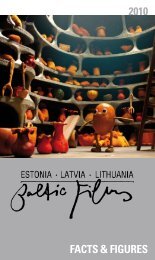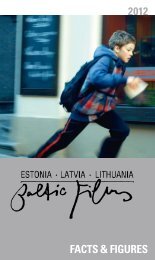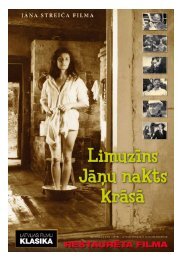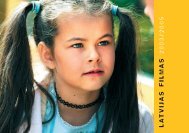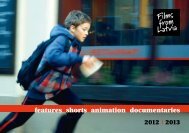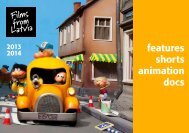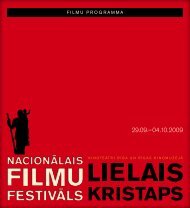Latvian Animation - NacionÄlais Kino centrs
Latvian Animation - NacionÄlais Kino centrs
Latvian Animation - NacionÄlais Kino centrs
You also want an ePaper? Increase the reach of your titles
YUMPU automatically turns print PDFs into web optimized ePapers that Google loves.
Defining Moments in <strong>Latvian</strong> <strong>Animation</strong><br />
Defining Moments in <strong>Latvian</strong> <strong>Animation</strong><br />
1991 Kā bērniņš nāk<br />
pasaulē How a Baby<br />
Comes Into the World<br />
■ The sexual revolution happened in<br />
Latvia thanks to Māris Putniņš, an artist<br />
and soon-to-be among the most<br />
visible <strong>Latvian</strong> puppet animation specialists.<br />
In 1989, he published a series<br />
of drawings showing that babies aren’t<br />
brought by storks or found in cabbage<br />
patches in the famous children’s magazine<br />
Zīlīte, This popular-science film by<br />
Roze Stiebra recreates this long-keptfrom-children<br />
truth on the big screen.<br />
1994 Aicinājums<br />
The Summons<br />
■ Studio Dauka makes a film to begin<br />
the series Pasaciņas (Little Fairy-Tales),<br />
1994 Munks un Lemijs. Lidojam?!<br />
Munk and Lemmy. Let’s Fly?!<br />
■ Director Nils Skapāns’ second film is in competition at the Berlinale Film Festival.<br />
Slightly bewildered by the turn of events and still not really knowing much<br />
about directing, he heads to one the<br />
world’s most prestigious film festivals,<br />
and becomes even more bewildered<br />
when his film wins a Crystal Bear. The<br />
award shatters into pieces in a plastic<br />
bag on the way home, but that doesn’t<br />
take away from the creator’s joy. One<br />
after the other, articles start to appear<br />
in the press praising the future of <strong>Latvian</strong><br />
animation.<br />
1998 Kiriku un burve Kirikou et la Sorciere<br />
■ Michel Ocelot’s award winning animation film Kirikou et la Sorciere (awards at<br />
Annecy <strong>Animation</strong> Film Festival, Chicago and Montreal) has names of <strong>Latvian</strong> animators<br />
in the credits. This is a successful start in the animation world arena, and is<br />
followed by work on the Oscar nominated Les triplettes de Belleville (2003).<br />
2001 Pavasaris Spring<br />
■ Nils Skapāns joins Juris Podnieks Studio and makes his first claymation film.<br />
Even though by the end of the film the snowman has become a shade of light gray,<br />
the KROK animated film festival recognizes his achievement with a special award.<br />
2002<br />
Vectēva Medus<br />
Grandad’s Honey<br />
■ Created as a graduation project at<br />
Konstfack, University College of Arts,<br />
Crafts and Design, Dept. of <strong>Animation</strong>,<br />
in Eksjo, Sweden, Vladimir Leschiov<br />
makes a notable entrance onto the<br />
<strong>Latvian</strong> animation scene. The director,<br />
having already tried his hand at<br />
making commercials, shows the local<br />
viewer a new form of drawing and<br />
in-frame detail, and convinces the national<br />
film festival Lielais Kristaps jury<br />
of his talent, as Vectēva Medus receives<br />
the award for best <strong>Latvian</strong> animation<br />
in 2003.<br />
2002 Sieviete Woman<br />
■ Signe Baumane first sat in the director’s chair in 1991 when she dared to make<br />
her dream of making animation come true. But only in 2009, after some 20 years<br />
of work, her film Dzemdības (Birth) is finally included in the Annecy film festival!<br />
Sieviete, made under the wing of Rija Films, is a philosophical study. Screened<br />
both in Woodstock and KROK, the film captivates viewers with the elusive and<br />
not wholly understandable inner world of a woman, and is in contrast with the<br />
films she creates in New York that are full of sexuality, and are often criticized by<br />
Latvia’s puritanical society.<br />
which is Roze Stiebra’s pet project.<br />
Through the more than twenty films<br />
that ensue, the viewer is introduced to<br />
<strong>Latvian</strong> stories, and popular <strong>Latvian</strong><br />
artists are brought into the world of animation – they light up the screen with<br />
shades of colours that, up to now, were only used on canvas.<br />
1999 Clara un Rubinšteins Clara and Rubinstein<br />
■ At the end of the 1990s, Askolds Saulītis is declared to be one of Latvia’s most<br />
promising young directors, and Studio Rija Films strikes while it’s hot. The first<br />
co-production film is made together<br />
with producer Paul Thiltges, who knew<br />
of the accomplishments of <strong>Latvian</strong><br />
animators from Kirikou et la Sorciere,<br />
and is, since 2008, a co-producer on<br />
Studio Rija Films’s upcoming feature<br />
Zelta Zirgs (Golden Horse). Clara un<br />
Rubinšteins is a mix of the director’s<br />
grandmother’s memories and nevermade<br />
films about excess weight. Artist<br />
Jurģis Krāsons received a Lielais<br />
Kristaps award for his work.<br />
1999 Velniņi<br />
The Little Devils<br />
■ Studio Rija Films releases Velniņi in<br />
the same year – a modernized screen<br />
version of a work by <strong>Latvian</strong> writer<br />
Rūdolfs Blaumanis, with voiceovers by<br />
local celebrities. An interactive game in<br />
CD format aimed at children follows.<br />
2003<br />
Jāņtārpiņš Firefly<br />
■ Dace Rīdūze, one of the large Studio<br />
AB family, directs Jāņtārpiņš, as part<br />
of the Animals series from Animācijas<br />
Brigāde. The film is screened at the Berlinale<br />
festival, and makes both adults<br />
and children think about tolerance. Is<br />
firefly Otis not as good as others because<br />
his glow-light doesn’t work?<br />
2004 Poēm pa kulšen<br />
■ One of rare, true cinematographic <strong>Latvian</strong> animation films is directed by Jānis<br />
Cimermanis under studio Animācijas Brigāde. The screenplay is based on a work<br />
by Fricis Dziesma published in 1948,<br />
on the tradition of grain threshing in<br />
the Kurzeme region. Alongside the human<br />
lives, there are also the joys and<br />
woes of the little animals, and the lively<br />
whirl of intertwining events carries the<br />
viewer into the distant past, perhaps<br />
recognizing the fond memories shared<br />
by their parents or grandparents.<br />
FN 2 | 10<br />
FN | 11 2


